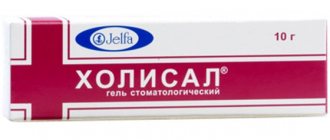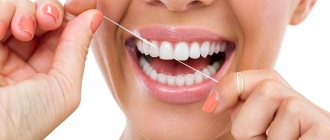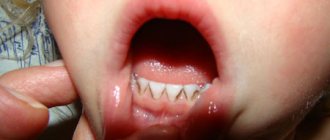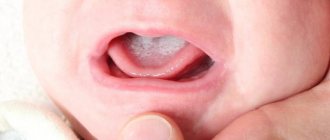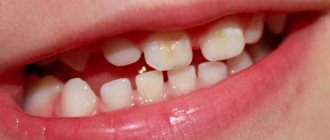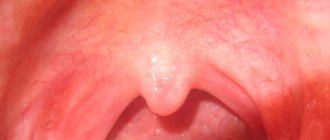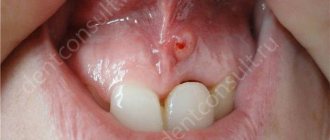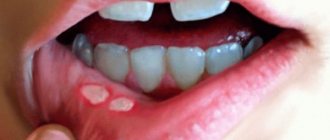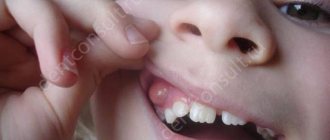Signs and symptoms of gum inflammation in a child with photos
Inflamed gums in a child are difficult to miss. Depending on the causes of the illness, the symptoms may vary. You can clearly see the symptoms of gum inflammation in a child in the photo accompanying the article. The most common symptoms of almost all diseases look like this:
- swelling of the gums and interdental papillae,
- redness of the gum tissue around the tooth (as the disease progresses, it becomes bluish),
- bleeding gums due to mechanical stress,
- pain during eating or hygiene procedures.
Note!
It is typical that with tension in the gums caused by teething, the child often acquires the habit of biting everything that is within his reach - from toys to cutlery. If the pain in the gums is caused by another reason, the child, on the contrary, avoids contact of the gums with a pacifier, spoon, etc.
During an infectious process in the gum tissue, an increase in body temperature is often observed. Depending on the type of pathogen that caused the disease, temperature readings can vary from 37.5°C to 39.0°C.
Fungal infection of the oral cavity has visually detectable signs: white or yellowish films may appear on the mucous membranes of the cheeks, gums and tongue, which, after removal, leave pronounced inflamed and sometimes even bleeding areas.
Another characteristic sign of the presence of an infection in the oral cavity is an unpleasant odor. Depending on the extent of the infection, the smell can only be detected from the mouth, but often it is felt even when exhaling air through the nose. The anatomical features of the structure of the nasopharynx and oropharynx in children allow infection to quickly spread from the oral cavity to adjacent areas - the nasal cavity, maxillary sinuses, and mucous membrane of the throat.
When complaining of pain in the gums, first of all, you should pay attention to the condition of the child’s teeth. If the pain is caused by the active phase of tooth growth, the gum looks healthy, but is slightly swollen - its color remains pink, it is sufficiently moisturized and there are no signs of infection (ulcers, films, unpleasant odor) and when pressing on it there is no separation of fluid, ichor or pus. But all these signs (or some of them) are present in inflammatory or infectious gum disease.
Causes of redness of the mucous membrane
Before taking measures to treat unpleasant symptoms, you will need to establish what causes led to the redness of the mucous membranes of the child’s mouth. The main factor provoking the development of inflammatory processes in the gingival tissue in both children and adults is the proliferation of pathogenic microorganisms. Most often this happens due to neglect of the rules of oral hygiene. Hard and soft dental deposits provide a breeding ground for pathogenic bacteria, the toxic waste products of which cause gum inflammation.
In children under 2 years of age
In infants and children aged 1–2 years, the formation of a temporary bite is actively underway, that is, baby teeth are simply coming out. Teething is almost always accompanied by redness of the gums. It can begin at 5–6 months or delay until one year of age. In the youngest patients, this is one of the most common causes.
Unpleasant symptoms can be caused by:
- deficiency of vitamins and nutrients – the condition of the gums is negatively affected by the lack of vitamin C in the baby’s body,
- injury - while playing, a child can injure the gum tissue with a hard or sharp object, where inflammation develops,
- stomatitis - if the gums are swollen and red, this is accompanied by the appearance of plaque and spots on the tongue and mucous membranes in the mouth, a general deterioration in health and an increase in body temperature, then the baby has most likely become infected with one of the forms of stomatitis (we recommend reading: what can be done, if your gums are swollen?),
- caries - even if the first tooth has just erupted, it is not immune from carious lesions; you should not neglect the treatment of caries in baby teeth - there is a risk of infection of the rudiments of the dental elements of the permanent dentition.
For children 3-7 years old and older
Problems with gums in children aged 3 years and older can be caused by the same factors that cause symptoms in the youngest patients, with the exception of the teething of the primary bite - it is already fully formed by that age.
The reasons that contribute to the development of pathogenic microflora in a child’s mouth and cause inflammation of the gums include:
- exacerbation of a chronic systemic disease,
- deficiency of vitamins E, B, C,
- hormonal imbalance (common in teenagers),
- gastrointestinal diseases,
- improper distribution of the chewing load on the teeth due to malocclusions or other local defects,
- failure to comply with personal hygiene rules,
- heredity,
- traumatic damage to mucous membranes,
- decreased immunity after an infectious disease,
- caries.
How to help your baby during teething
The appearance of teeth is a very difficult and worrying stage in the life of babies and their parents. The child experiences severe pain and discomfort. You can alleviate your baby's condition at home.
- Modern medicine offers many means and methods that will relieve a child of suffering during the appearance of teeth:
- Gum massage. The method helps relieve itching and pain and speed up the process of tooth eruption. You can use simple gauze to massage your gums. It is moistened in water or chamomile decoction, wrapped around a finger, and moved lightly along the gum. Special silicone finger pads are also used for massage. They can be purchased at any pharmacy.
- Use of local anti-inflammatory drugs. Gels and ointments with herbal ingredients are widely used. For newborns it is recommended to use “Baby Doctor, First Teeth”. For children over 6 months old, you can use Kalgel with lidocaine, Cholisal and Dentinox.
- Oral use of anti-inflammatory drugs. You can bring down your child’s temperature and relieve pain with the help of children’s “Nurofen” in a convenient suspension form. The drug can be used in children from three months of age.
Teething - inflammation
Some herbal preparations can cause allergies in a child. If a rash or swelling of the mucous membranes appears, you should stop taking the drug and contact your pediatrician.
During teething, special attention should be paid to the baby's nutrition. You should not give sweetened drinks to avoid the development of caries. You also need to pay attention to hygiene. The baby's tongue should be cleaned with moistened gauze in the morning. All procedures should be carried out only with clean hands.
Read also: Tooth root is exposed
Teething aids
Possible oral diseases
Gum disease in children is common. Children often encounter various forms of gingivitis, periodontitis, and stomatitis. Sometimes swollen gums indicate that a child is suffering from periodontal disease. Regardless of what pathological process has affected the baby’s oral cavity, he will need the help of a specialist in identifying the causes and selecting treatment.
Gingivitis in children
Gingivitis is an inflammatory process that develops in the gum tissue. Children tend to suffer from this disease more often than adults. The pathology can occur even in infants, but most often school-age children, from 7 to 16 years old, suffer from gingivitis.
In children, gingivitis can be caused by a short frenulum of the lip. If this defect has not disappeared by the age of two, then surgery is required. One of the following forms of gingivitis may develop:
- atrophic,
- ulcerative-necrotic,
- hypertrophic,
- hyperplastic,
- desquamative,
- marginal,
- catarrhal
Periodontal inflammation (periodontitis)
Periodontitis is an inflammatory process that affects the periodontium, that is, the tissue that attaches the tooth to the jaw. In children, depending on their age, a prepubertal (up to 11 years of age) or pubertal (11 years of age and older) form of the disease can develop. The prepubertal form usually appears during the formation of a temporary occlusion; its main difference is that the gums do not hurt.
The following symptoms are typical for childhood periodontitis:
- purulent exudate is released from the periodontal pockets,
- salivary secretion becomes thick,
- bad breath (we recommend reading: bad breath in a 3-year-old child: causes and treatment),
- bad taste in the mouth,
- heat and itching in the gums.
Stomatitis
There are several forms of stomatitis that can develop in childhood. Schoolchildren are most often affected by allergic or aphthous stomatitis; children from 1 to 3 years of age are more likely to suffer from Bednar's aphthous stomatitis or suffer from the herpetic form of the disease. From birth to the age of three, a child is at risk of contracting oral candidiasis. The bacterial type of disease affects children of any age.
Caries
Caries develops equally often in children and adults. It should be taken into account that carious lesions of teeth in the temporary occlusion have their own distinctive features. This is due to the specific structure of the mammary units, in particular the small thickness of the protective enamel layer.
Features of caries in children:
- may develop immediately after tooth eruption,
- often asymptomatic, even in the presence of significant lesions,
- sometimes planar or circular caries forms - such forms of pathology occur only in children,
- multiple lesions are characteristic - sometimes the pathological process spreads to the entire row of teeth,
- often develops after an infectious disease,
- progresses faster than in adults.
READ IN DETAIL: caries in children under 2 years of age: what to do if a child’s baby teeth are affected at an early age?
Dystrophic diseases
Periodontal disease is one of the dystrophic gum diseases that develop in children.
Improper oral hygiene, weakened immunity, allergies, endocrine system dysfunction in combination with genetic predisposition can lead to periodontal disease.
In the early stages, there are no pronounced signs - babies sometimes complain of increased sensitivity to temperature stimuli. As the disease progresses, the following symptoms appear:
- unpleasant odor from the mouth,
- tooth enamel changes color
- gums turn pale and itch,
- the cervical part of the tooth is exposed,
- teeth become loose and may fall out.
INTERESTING: Why do teeth sometimes itch during pregnancy?
Gingivitis in children: symptoms, treatment
Gingivitis is an inflammation of the marginal gum adjacent to the teeth and interdental papillae (Fig. 1-3). Gingivitis is the very initial phase of inflammation, and if it is not treated, the inflammation will increase, the bone around the tooth may begin to deteriorate, and tooth mobility will also appear.
Gingivitis in children: photo
Gingivitis in children: symptoms
- bleeding gums,
- pain when brushing teeth,
- swelling of the marginal gums and interdental papillae,
- redness of the gums – red gums in a child are a symptom of the acute phase of inflammation,
- cyanosis of the gums – a child will have blue gums if acute inflammation becomes chronic, with mild symptoms.
An objective examination of the oral cavity reveals accumulations of soft plaque and hard dental deposits, and, as a rule, a large number of carious teeth (24stoma.ru).
Childhood gingivitis: causes
So, we answer the question: why do a child’s gums bleed... The cause of the development of gingivitis is the microbial flora of dental plaque. Due to poor hygiene, plaque accumulates, the microflora of which actively produces toxins and inflammatory mediators. These toxins and mediators, acting on the gums, cause an intense inflammatory reaction in it, which is manifested by the development of edema, bleeding, etc.
Those. The main factor in the development of gingivitis is soft microbial plaque and dental deposits, i.e. bad hygiene!
Factors contributing to the development of gingivitis - in addition to the main factor, there are additional factors that do not themselves cause inflammation, but contribute to its occurrence. ..
- Local factors – → defects in dental filling (overhanging edges of fillings), → malocclusion: crowding of teeth, → sharp edges of carious cavities (Fig. 4), → wearing orthodontic appliances (Fig. 5), → mouth breathing, → anomalies in the attachment of lip frenulum and language. The listed local factors do not themselves cause gingivitis, but they complicate oral hygiene and therefore contribute to the accumulation of plaque.
- Common factors are cardiovascular and gastrointestinal diseases, infectious diseases (including ARVI), hormonal and hereditary diseases. These factors lead to a change in the body's reactivity (decreased immunity) - due to which the resistance of the gums to toxins and inflammatory mediators produced by the microbial flora of dental plaque is reduced.
Gingivitis: treatment in children
As we said above, gingivitis in children occurs only when microbial plaque and dental deposits accumulate on the teeth. In this regard, appropriate therapeutic measures are selected. Treatment of gingivitis in children should include the following measures:
- Removing plaque and tartar –You can remove dental plaque by conducting a session of professional oral hygiene at a dentist’s appointment. Dental plaque is removed using ultrasound, after which the teeth are polished with special brushes. The procedure is painless.
In Fig. 6 you can see the ultrasonic tip, which is used to remove dental plaque. Touching the tip of the nozzle to dental plaque causes destruction of the attachment of tartar to the teeth.Important : gingivitis in children - treatment consists primarily of removing soft microbial plaque and hard dental deposits from the teeth using ultrasound. An attempt to use various rinses, gels with antibiotics and antiseptics, toothpastes with herbs will, of course, lead to a temporary subsidence of inflammation. But as soon as the use of medications ends, inflammation will develop with renewed vigor. Anti-inflammatory therapy should be used only after removing tartar and plaque!
- Anti-inflammatory therapy –Bleeding gums in children is one of the main symptoms of gingivitis, along with pain when brushing teeth, swelling and redness of the marginal gums. In order to quickly relieve symptoms, it is necessary to conduct a course of anti-inflammatory therapy. A child's inflamed gums can be treated with the following dosage forms: antiseptic rinses, applications.
Antiseptic rinses:- 0.05% CHLORHEXIDINE SOLUTION (instructions for the drug) Course 10 days (no more), 2 times a day in the morning and evening after oral hygiene. It is advisable to rinse your mouth for at least 30-40 seconds. There are no contraindications based on age. The solution has a bitter taste.
MIRAMISTIN (instructions for the drug) rinse solution for children from 3 years old. Rinse 3-4 times a day for 30-40 seconds. Miramistin is somewhat inferior to chlorhexidine in terms of potency, and besides, it is much more expensive.
- Non-alcohol infusions of herbs - chamomile, sage, eucalyptus... (except oak bark)
Anti-inflammatory gels, ointments:
Questions are often asked: what to smear on a child’s gums, what is better – gel or ointment for gums for children? Children's ointment for gums will be noticeably inferior in strength to gels for gums. Gels are much better retained on the moist mucous membrane of the oral cavity. In addition, medicinal substances from gels penetrate the mucous membrane more easily than from ointments. Therefore, the effectiveness of dosage forms based on gels is higher.
- CHOLISAL (instructions for the drug) Gel for children's gums.
Active ingredients: choline salicylate and cetalkonium chloride. It has not only an anti-inflammatory, but also an analgesic effect. It can be used not only in the treatment of gingivitis, but also during teething for the purpose of pain relief (rubbed into the teething area). There are no contraindications based on age. It is applied to the marginal part of the gums and gingival papillae, primarily from the front surface of the teeth. The course is no more than 10 days. Apply 2 times a day (in the morning and in the evening before bed) immediately after the end of the antiseptic rinse. After application, it is advisable not to eat or rinse your mouth for 2-3 hours (you can drink). - METROGYL DENTA (instructions for the drug) Gel for gums for children. Active ingredients: metronidazole 10 mg, chlorhexidine 0.5 mg Can be used from 6 years of age. Apply to the marginal part of the gums and interdental papillae in the area of all gum teeth 2 times a day. It is not recommended to wash off the gel. After applying the gel, it is advisable not to eat or rinse your mouth for 2-3 hours (you can drink). The duration of the course of treatment is no more than 10 days.
If you decide to treat your child yourself , then you need to know that removing dental plaque before starting treatment is mandatory. If anti-inflammatory therapy is used without removing soft and hard plaque, it will cause the following:
→ symptoms (bleeding, swelling, etc.) will certainly decrease or disappear. But, as soon as the course of treatment ends, the symptoms will arise again. This is because the cause of gingivitis (microbial plaque) was not removed and treatment was only given for symptoms.
→ the transition of gingivitis from an acute form with severe symptoms to a chronic form with scanty symptoms, which with a high probability can result in the development of periodontitis in a child.
In carious cavities there is a lot of infection, which causes not only tooth decay, but also inflammation of the gums. In young children, the so-called bottle form of caries often occurs, which is associated not only with poor hygiene and improper feeding of the child. When treating caries in children under 3 years of age, as a rule, dental clinics use the method of silvering teeth. Despite the fact that this method does not require drilling of teeth, it has major disadvantages, and is also inferior in effectiveness to others, for example, the method of deep fluoridation or remineralization therapy.
What to do if your gums are swollen, and how to help your baby?
If your baby's gums are red and swollen, you should first consult a doctor to find out the reasons for this phenomenon. He will conduct a diagnosis and select a set of therapeutic measures that will help the child quickly cope with the disease and will not harm his fragile health. You cannot prescribe treatment for children on your own.
| Disease | Medicines for early stage therapy | Folk remedies |
| Gingivitis |
|
|
| Periodontitis |
|
|
| Stomatitis |
|
|
Complications
One of the most common complications of oral diseases in children is their chronicity. The disease, left without treatment, quickly acquires a chronic course, in which periods of exacerbation alternate with a relatively calm period when symptoms do not appear at all or appear slightly.
Chronic stomatitis photo
The second most common problem caused by oral diseases in children is a violation of local immunity and the resulting frequent diseases of the throat, pharynx, larynx, trachea, nasal cavity, sinuses, Eustachian tube and middle ear. In fact, with untreated diseases of the teeth and gums, all nearby organs and tissues are affected. And medical problems with them lead to complications of a higher level - frequent sore throats and a high probability of systemic consequences, sinusitis and the risk of inflammation spreading to the eyes, brain, etc.
